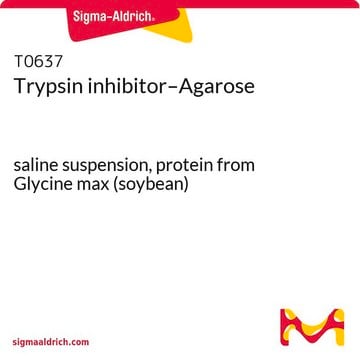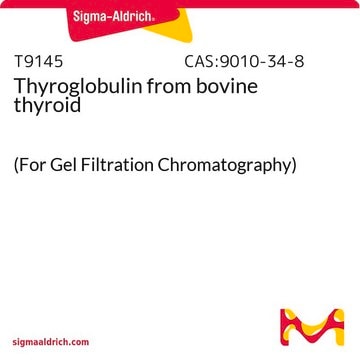10109886001
Roche
Trypsin Inhibitor
from soybean
Synonyme(s) :
trypsin
Se connecterpour consulter vos tarifs contractuels et ceux de votre entreprise/organisme
About This Item
Code UNSPSC :
12352207
Produits recommandés
Source biologique
soybean
Niveau de qualité
Forme
lyophilized
Poids mol.
Mr 20,100
Conditionnement
pkg of 50 mg
Fabricant/nom de marque
Roche
Concentration
1 mg/mL
Technique(s)
cell culture | mammalian: suitable
pH
3.8-4.5
Solubilité
water: soluble
Température de stockage
2-8°C
Description générale
Soybean trypsin inhibitor (STI) comprises 181 amino acids. It is a monomeric protein corresponding to a molecular weight of 20 kDa and has two disulfide bridges. It belongs to serpins − serine protease inhibitors family.
Spécificité
Soybean trypsin inhibitor is an inhibitor for trypsin, plasmin, and plasma kallikrein. It inhibits trypsin, factor Xa, plasmin, and plasma kallikrein activity in serum-free cell culture media. It does not inhibit metallo-, cysteine, aspartic proteases, or tissue kallikrein (serine proteases).
Application
Trypsin Inhibitor from soybean is used to terminate tissue disaggregation and for subcultivation procedures.
Trypsin Inhibitor has been used:
- in the buffer for hepatocyte isolation
- to inhibit trypsin in Corneal epithelial cells
- to inhibit papain activity while treating hippocampal neural stem cells (NSCs)
Actions biochimiques/physiologiques
Soybean trypsin inhibitor (STI) inhibits myc proto-oncogene protein and is anticarcinogenic. It favors anti-aggregation of platelets and may be a potential protease inhibiting drug. STI inhibits renin and angiotensin.
Soybean trypsin inhibitor is an inhibitor for trypsin, plasmin, and plasma kallikrein. The product is sensitive to heat, alkaline pH, and protein-precipitating compounds.
Caractéristiques
Inhibiting activity: approximately 70 trypsin inhibitor units/mg lyophilizate at +25°C with benzoyl-L-arginine ethylester as a substrate (approximately 190 trypsin inhibitor units/mg at +25°C with Chromozym TRY as substrate)
Isoelectric point: 4.5
Isoelectric point: 4.5
Définition de l'unité
1 U = 270 S & T-units or 90 USP-units
Notes préparatoires
Working concentration: 10 to 100 μg/ml
Working solution: Recommended solvent is distilled water.
Stock solution: 1 mg/ml
Storage conditions (working solution): -15 to -25 °C
The enzyme is stable for 6 months, frozen in aliquots.
Working solution: Recommended solvent is distilled water.
Stock solution: 1 mg/ml
Storage conditions (working solution): -15 to -25 °C
The enzyme is stable for 6 months, frozen in aliquots.
Reconstitution
Sensitive to heat, alkaline pH, and protein-precipitating compounds.
Stockage et stabilité
Store at 2 to 8 °C. (Store dry!)
Autres remarques
For life science research only. Not for use in diagnostic procedures.
Code de la classe de stockage
11 - Combustible Solids
Classe de danger pour l'eau (WGK)
WGK 2
Point d'éclair (°F)
Not applicable
Point d'éclair (°C)
Not applicable
Certificats d'analyse (COA)
Recherchez un Certificats d'analyse (COA) en saisissant le numéro de lot du produit. Les numéros de lot figurent sur l'étiquette du produit après les mots "Lot" ou "Batch".
Déjà en possession de ce produit ?
Retrouvez la documentation relative aux produits que vous avez récemment achetés dans la Bibliothèque de documents.
Les clients ont également consulté
Mice, double deficient in lysosomal serine carboxypeptidases Scpep1 and Cathepsin A develop the hyperproliferative vesicular corneal dystrophy and hypertrophic skin thickenings
Pan X, et al.
PLoS ONE, 12(2), e0172854-e0172854 (2017)
Preparation of Primary Rat Hepatocyte Spheroids Utilizing the Liquid-Overlay Technique
Kyffin JA, et al.
Current Protocols in Toxicology / Editorial Board, Mahin D. Maines (editor-in-chief) ... [Et al.], 81(1), e87-e87 (2019)
Single cell transcriptomic analysis of renal allograft rejection reveals insights into intragraft TCR clonality.
Shi, et al.
The Journal of Clinical Investigation (2023)
Isolating Taste Buds and Taste Cells from Vallate Papillae of C57BL/6J Mice for Detecting Transmitter Secretion
Anthony Y. Huang and Sandy Y. Wu
CorpBase ID (for auto-filling citation data), 6(11) (2016)
proBDNF is modified by advanced glycation end products in Alzheimer?s disease and causes neuronal apoptosis by inducing p75 neurotrophin receptor processing
Fleitas C, et al.
Molecular Brain, 11(1), 68-68 (2018)
Notre équipe de scientifiques dispose d'une expérience dans tous les secteurs de la recherche, notamment en sciences de la vie, science des matériaux, synthèse chimique, chromatographie, analyse et dans de nombreux autres domaines..
Contacter notre Service technique







